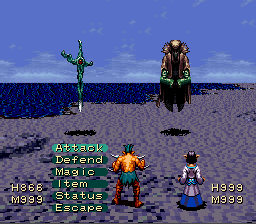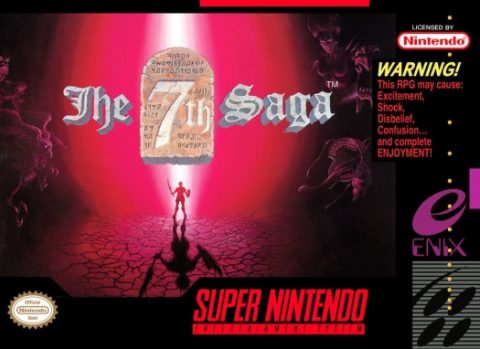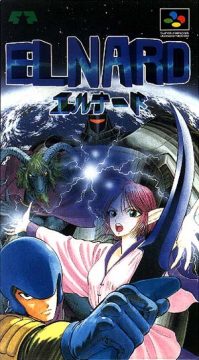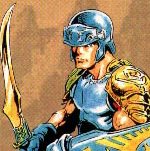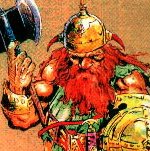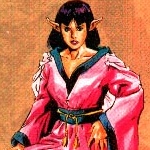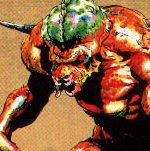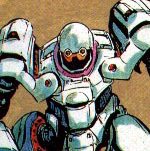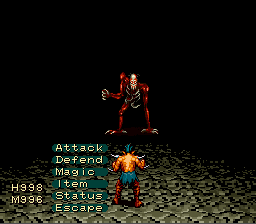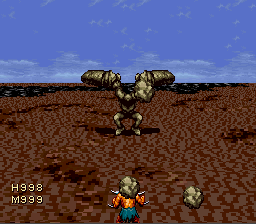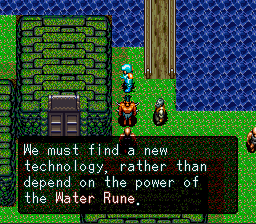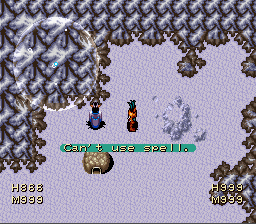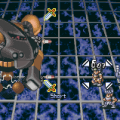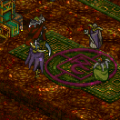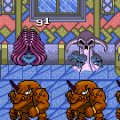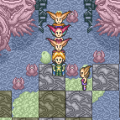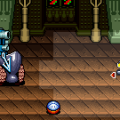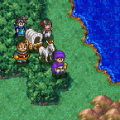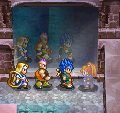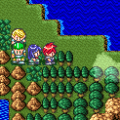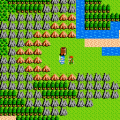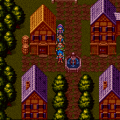The early nineties were an interesting time for the Japanese RPG. Final Fantasy had already been around for a few years, but you still had many other developers doing their own thing as many of the genre’s current cliches and design standards hadn’t been fully embraced yet. Many of these games suffered a bit from the lack of identity, often trying to merge concepts and world design of more complex computer RPGs like Wizardry with the streamlined combat and more unique characters found in Final Fantasy and Dragon Quest. The 7th Saga is one such game. Its combat and difficulty is wildly off balance. Its graphics are a mix of choppy “3D” effects and barely animated sprites. Its music alternates between beautifully contemplative and slapstick within minutes. Most importantly, The 7th Saga‘s translation is less than ideal, getting the basic plot of the game’s story across and not much else. The simplicity of the English script is actually a source of much amusement.
With so much going against it, why does it still have a cult following to this day? Unlike most RPGs before or since, instead of creating a character or taking control of a single individual, you get to choose from seven different characters to complete the game with. Each one has a completely different look along with different abilities, weapons, and even different ways of completing parts of the game’s story. The story itself is simple, but does a great job of playing into having seven different characters to choose from. These heroes are trained by a king to help him locate seven Runes which will grant whoever holds them all massive power.
Characters
Kamil Dowanna
An average, well rounded knight. He gets a little of everything but isn’t particularly good at anything, the most boring character.
Olvan Jess
This guy’s great, a powerful dwarf that, while lacking some of Kamil’s magical prowess, hits enemies so hard it doesn’t matter. Also, interestingly, there’s a special encounter only Olvan can get: a character recognizes him and gives him a key to an area meant to be reached much later in the game.
Esuna Busy
An elf that uses powerful ice magic, she’s also very fast which lets her usually go first in battle. Her biggest advantage is that her magic points are so high that she’s the only character where you could realistically throw out powerful magic spells every turn. This makes her a great character to have with anyone else in the game.
Wilme Pelin
This guy’s pretty interesting. Listed as an “alien” in the game, he’s a tall orange fellow with a tuft of green hair. The game’s sprite evokes a hulking carrot man not unlike Taebo from “Lost in Space,” though the artwork in the manual depicts a more overtly monstrous character. He has very high defense and strength, plus he gains levels and abilities much faster than most other characters. His disadvantage is that there are only two or three armor and weapons available for him to equip in the entire game. He attacks enemies by setting his arm on fire and punching them. By “alien,” the developers more likely meant an outsider or exile, as events in the game’s story will show.
Lux Tizer
Lux is one of about thirty survivors of a race of robots built by a lost civilization. They actually made a couple of unique robot sprites just so you can run into a few throughout the game that behave like regular townspeople! He seeks the runes to help learn the origin of his people and the purpose of his existence. His stats are similar to Wilme’s except he has a bit more magical ability at the cost of lower speed. As an extra detail, a metallic clanging sound effect is used whenever Lux walks.
Valsu Sizer
This guy is a pretty typical healer character. His advantage is that if you actually level him up enough, he learns a spell that fully heals him. He’s almost impossible to play as before you find a partner to cover his weaknesses, but if you stick with him long enough to learn that spell, he can only be defeated by attacks that knock him out in a single hit!
Lejes Rimul
This guy’s awesome. A power hungry demon with a wide variety of offensive magic, Lejes does have difficulty getting along with the other characters. He, Kamil, Esuna and Lux were chosen to be on the cover of the game’s Japanese release. His other advantage is that unlike the other inhuman characters he can equip a good variety of weapons so that his physical attacks won’t fall behind as his magical abilities grow.
Once you take your lone character and venture out into the world for a bit, things start to get interesting. First off, this is one of the few console RPGs of the time where the cities you visit have NPCs that acknowledge how the other cities work. There are many more places to visit than in most other console RPGs, and they each have a unique look and a unique purpose in the game’s world. It really helps sell the setting of the game that the many people you can talk to will give you consistent information about the different cities’ trade routes, economies, and so on. The large map you walk around to go from place to place is swarming with enemies, but early on you are given a crystal ball that shows you their location, the locations of places you can visit, and most importantly, the location of a Rune if it’s within the crystal ball’s range.
That last part is where The 7th Saga excels. The game feels truly epic in scope, with a vast world to travel across that, unlike the sense of urgency depicted in most games, gives the impression of years of time passing by as you investigate every lead you can to find the Runes. The soundtrack adds to this adventuresome atmosphere. Something unique to The 7th Saga‘s soundtrack at the time is that it actually has several different songs for different types of towns as well as for different parts of the game’s world map. Today RPG franchises like Shin Megami Tensei pride themselves on having a huge track list, but for a small developer like Produce to come out of nowhere with this much musical variety in such a long game was very impressive for the time.
Now while you’re adventuring around battling The 7th Saga’s many cool looking monsters, the game moves the six heroes you didn’t choose around the game world also. Each town has a couple of places where one has a chance to show up. When you run into one, they might join your party, making the game much easier. They might just reject you, or, if they or you have a Rune or two, they’ll attempt to fight you. If you defeat one of these other characters they are permanently gone. The more Runes you have, the higher the odds another character will attack you outright instead of giving you a choice or offering to join you.
This is the most interesting aspect of the game, since you want to have a second character with you, and will at times want to find a specific one to help exploit a specific enemy’s weaknesses or to cover your own, but you also run the risk of removing that character from the game entirely. Said removal is no joke either, as opposing heroes are given absurdly high vitality and healing spells even if the character can never learn healing magic when you play as them! The good thing is that while you can only have two characters in your party total, you can switch your partner out whenever you find someone else willing to join you and then switch back later.
Seeking out the Runes is extremely important for your character as well, and unlike in other RPGs with a quest to find ancient artifacts, you immediately find out why. Rather than an artifact that only exists to further the story, each Rune is a unique item that you can use repeatedly once you find it. They give your character very useful abilities like being able to instantly travel to any city you’ve previously visited, doubling your attack power in combat, replenishing your magic energy, and so on. There’s even a plot point in the game where one of the other heroes is randomly chosen to find a Rune and use it to conquer a small kingdom. You have to kill him to get it, though interestingly, Esuna and Lux will never be chosen to fill this villainous role. Maybe it conflicts with their characters’ motivations, but since Esuna is the only female character in the game and Lux’s dialogue is capitalized because he’s an awesome robot, the developers may have just not wanted to bother with the unique sets of dialogue that would be needed to have them fit into this scenario.
The combination of the Runes actually being useful, the openness of the game’s world, and the other heroes being on the same quest as you and changing from friend to foe as you get more powerful keeps the game interesting and unpredictable. How you progress through the game can also change depending on your character. If you play as the three inhuman characters (Lux, Lejes and Wilme) as an example, you won’t be able to buy passage on a ship to get to another part of the game, so you have to go through an underground cavern and other parts of the game in a different order from everyone else. Later on, you run into a serpent woman that kidnaps children. Depending on which towns you visit and who you talk to, your reward for defeating her and her motivations for doing this will be different.
While the game was developed and released in 1993, this conflicted structure is reminiscent of earlier Megami Tensei and Phantasy Star games in its merger of the challenge of the Wizardry with the more unique character designs and streamlined combat systems of the Japanese developed RPGs.
That challenge is taken to an extreme level in the US release of the game. The 7th Saga was a difficult game for its time with its variety of clues to find and relentless enemies to overcome, but for the US release, the game was made even more difficult. Enemies were made more powerful, and the game’s experience system was changed so that your own characters grow and learn new abilities at a much slower rate. This makes playing with physically weaker characters like Valsu or Esuna almost impossible in the early game as it will take longer for them to learn their important magical skills. No matter which character you choose you will spend an hour or so fighting a lone bird over and over again outside of the first town and barely surviving. The game’s intro makes a huge deal out of the great training your characters received over the past few years, but in the US version of the game even a single, plain old bird can easily crush you the minute you set foot outside of the castle.
The increased difficulty is what hurts this game the most. Even for its time it was extremely tedious, but when you combine the many difficult battles with having to constantly search places for items as well as the complex world design (no really, when someone tells you that a place is just west of your current location, that means walk east, north, east, north, and then walk west across the entire game world, this happens more than once) and vague translations of what your abilities can do, it gets a bit too dated for its own good.
It also makes this possibly the most difficult RPG on the SNES. The player has to overcome not only this far more difficult take on the game’s combat, but also deal with the many bits of padding already built into the game’s story. As an example, at one point another character has stolen one of the Runes from its resting place. To find this out you have to trek the far north east of the game’s world, make your way through a destroyed city, and battle an uncooperative dragon. Your reward for this is that you can walk onto the space the dragon was standing on so that you can see the Rune is no longer on its pedestal. This is on top of other dirty tricks the game pulls like removing your ability to cast magic spells (!!?) out of nowhere until you find the individual person that caused this and steal an item out of a dungeon for him. Or an evil king that can only be defeated by going into the prison below his castle and pushing a table aside to reveal a key that lets you get the item needed to beat him. This is the only point in the entire game where you have to push something and, due to the layout of the area, it’s possible to not even get near enough to the object to realize it can be moved.
While the game’s developer, Produce, made a spiritual successor by the name of Mystic Ark along with a few other titles, The 7th Saga remains a singular experience. It’s a dated game, and the unnecessary difficulty increase will be a turn off for many gamers. At the same time, while it looks like an average Final Fantasy clone on the surface, the juxtaposition of the game’s goofier than intended translation with a weirdly somber setting and unique party mechanics makes for a surprisingly rewarding game.
Links:
The 7th Sark – An archived 7th Saga/Mystic Ark fan site, character scans from here.
